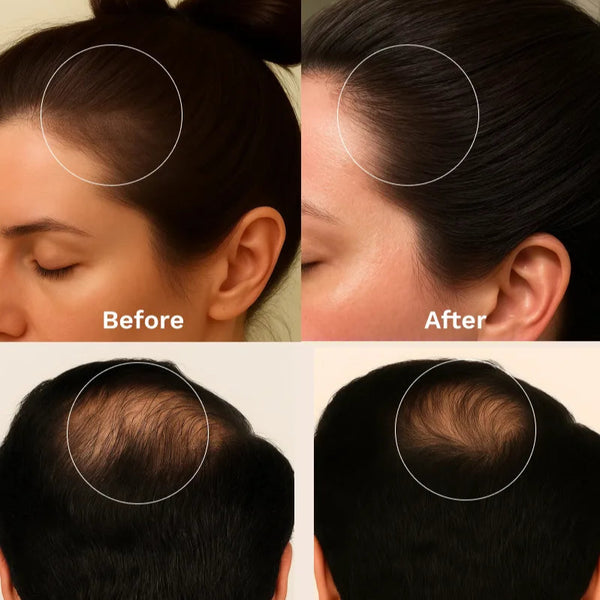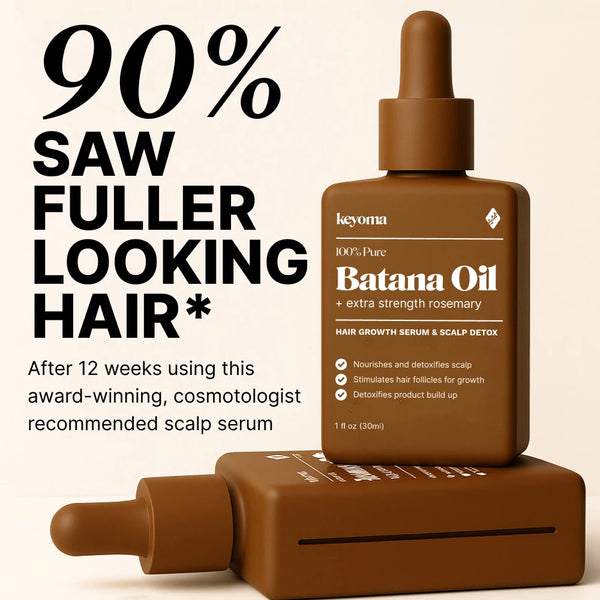In this article
If you are staring at your hairline in the mirror and wondering if it is fading, you are not alone. A lot of people start noticing changes earlier than they expect. The good news is there are ways to slow it down, support growth, or even regrow parts of it—depending on what is causing the shift.
Your hairline is not set in stone. Sometimes it moves because of genetics. Other times, it reacts to stress, diet, or how you treat your scalp. And while some damage is hard to reverse, many people are able to make real progress with small, consistent steps.
If you are unsure where to begin, start here.
Why Hairlines Recede in the First Place
A receding hairline does not always show up with warning. One day, your forehead feels bigger or your temples look thinner, and you start to wonder if you are imagining it. You are not.
- Genetics are usually the biggest reason. If male or female pattern baldness runs in your family, there is a good chance it plays a role in how your hairline behaves. But genes are not the only factor.
- Hormonal shifts can influence hair growth too. DHT, a hormone linked to testosterone, shrinks hair follicles over time. And that slow change often shows up first along the hairline.
Then there is stress. Not the occasional kind, but the chronic stuff. High stress levels can disrupt your cycle and push more strands into the shedding phase. Add poor sleep, crash diets, or tight hairstyles and your hairline takes even more of a hit.
You might be doing everything else right, but everyday habits could be setting you back.
Early Signs You Should Not Ignore

Hairline changes often start subtly. You might not even notice until you catch a different angle in the mirror. That moment of doubt? It usually means something is shifting.
Look for these signs:
- Thinning at the temples or a higher forehead than usual
- Extra hairs in the shower drain or scattered across your pillow
- A scalp that feels itchy, sensitive, or looks red more than usual
These are not always signs of permanent loss, but they do mean your scalp and follicles are under pressure.
Early signs are your chance to take action—not a reason to panic.
What Can Be Saved (And What Can’t)
If your hairline is shifting, the next question is natural: can you get any of it back? That depends on what kind of hair loss you are dealing with. Some types respond well to changes and treatment. Others, not so much. Understanding which one you are facing is your first step forward.
Temporary Hair Loss

Not all hair loss is permanent. When your hairline starts to shift because of stress, a recent illness, or poor nutrition, there is a good chance it will come back. This kind of shedding is known as telogen effluvium.
It usually happens a few weeks or months after the trigger. So if you are recovering from something intense—like surgery, a tough breakup, or a sudden diet change—that could explain the shift.
The good news is this type of loss often resolves on its own once your body finds balance again.
Permanent Hair Loss

This type of hair loss usually comes from genetic causes like male or female pattern baldness. Over time, your hair follicles shrink, and the hair becomes finer, shorter, and eventually stops growing altogether.
Unlike temporary shedding, this is not something that fixes itself. You often need consistent, targeted treatment to slow it down or make any recovery.
And once the follicles close up completely, regrowth becomes unlikely.
It is not your fault. But it does require action if you want to hold onto what you still have.
Can You Regrow It?
Yes, but it depends on what type of hair loss you are dealing with. If it is temporary hair loss, your chances are better. Your body often just needs time, rest, and a few supportive changes to bounce back.
With permanent hair loss, the situation is different. You are not likely to see regrowth without help. Treatments like minoxidil or finasteride can make a difference for some, especially if you catch it early. But results take time, and not everyone responds the same way.
The bottom line? You will not know what is possible until you start trying. The earlier you act, the more you give your hairline a fighting chance.
Simple Habits That Help

You do not need a prescription to start helping your hairline. Sometimes, it begins with small everyday shifts. These habits support your scalp and can slow down or even reverse early loss:
- Use gentle shampoos and avoid washing with hot water
- Massage your scalp for a few minutes a day to increase blood flow
- Sleep at consistent hours to reduce stress on your system
- Eat enough protein, iron, and healthy fats
- Avoid tight hairstyles, excessive brushing, or harsh treatments
These steps will not change things overnight. But they can set the stage for better results if you choose to try other treatments later.
Good hair habits are not flashy. But they work when you stick with them.
Over-the-Counter Options to Know
If your hairline is shifting and you want to try something simple before going all-in on treatments, over-the-counter options can help. But not all of them work the same.
Start with something natural. Batana oil is rich in fatty acids and nutrients that support scalp repair, moisture retention, and stronger strands. It is part of Keyoma’s collection for a reason. If you are unsure where to begin, this is your safest first move.
Minoxidil is another popular option. It works by stimulating blood flow to the follicles and extending the growth phase of your hair. It is one of the few ingredients backed by research—but it takes time and consistency.
Hair serums get a lot of hype, but not all deliver. Many are cosmetic and only mask the problem without treating the root cause. Look for ones that support the scalp, not just the hair.
If you are experimenting with oils, rosemary, peppermint, and castor oil have shown mild benefit in supporting circulation and follicle health. But start with one and be consistent.
You do not need ten different products. You need the right one used well.
FAQs
How can I permanently fix my hairline?
To permanently fix your hairline, you need consistent treatment and lifestyle changes. Options like minoxidil, finasteride, or a hair transplant can help you maintain or restore growth, depending on your situation.
Can a cut hairline grow back?
A cut hairline can grow back if the follicles were not permanently damaged. But if the cut was deep or repeated over time, regrowth might be limited.
How can I save my bad hairline?
To save your bad hairline, start by improving your scalp health, avoiding tight hairstyles, and using proven treatments like Batana oil or minoxidil. Early action gives you the best shot.
How to regrow frontal hairline?
To regrow a frontal hairline, focus on improving scalp circulation, reducing stress, and using treatments like minoxidil or Batana oil. Early, consistent care makes a difference.
Is stage 2 hair loss reversible?
Stage 2 hair loss is often reversible if addressed early. With consistent care, lifestyle changes, and treatments like minoxidil, many people see improvement.
Start Saving Your Hairline Before It Gets Worse
The sooner you pay attention to your hairline, the more options you have. Waiting makes it harder. Acting now—whether with natural oils, habit changes, or proven treatments—puts you back in control.
If you are not sure where to begin, try Batana oil from Keyoma’s collection. It is simple, effective, and kind to your scalp.
Your hairline does not have to keep fading. Start saving it today.
Featured Product
100% Pure Batana Oil + Rosemary
↓Best Batana Oil to Buy↓
1 Month
Subscribe & Save
- 30-day supply delivered monthly $35
- 30% off for life $6
- Free haircare essentials kit $33
- Free custom wooden comb $10
- Free scalp massager $15
- Free eco-friendly travel bag $8
- 30-Day Money Back Guarantee
- Free Shipping
- Online portal for easy cancel, skip, or pause.
1 Month One Time Purchase

- 30-day supply $50
- 30% off for life $6
- Free haircare essentials kit $33
- Free custom wooden comb $10
- Free scalp massager $15
- Free eco-friendly travel bag $8








